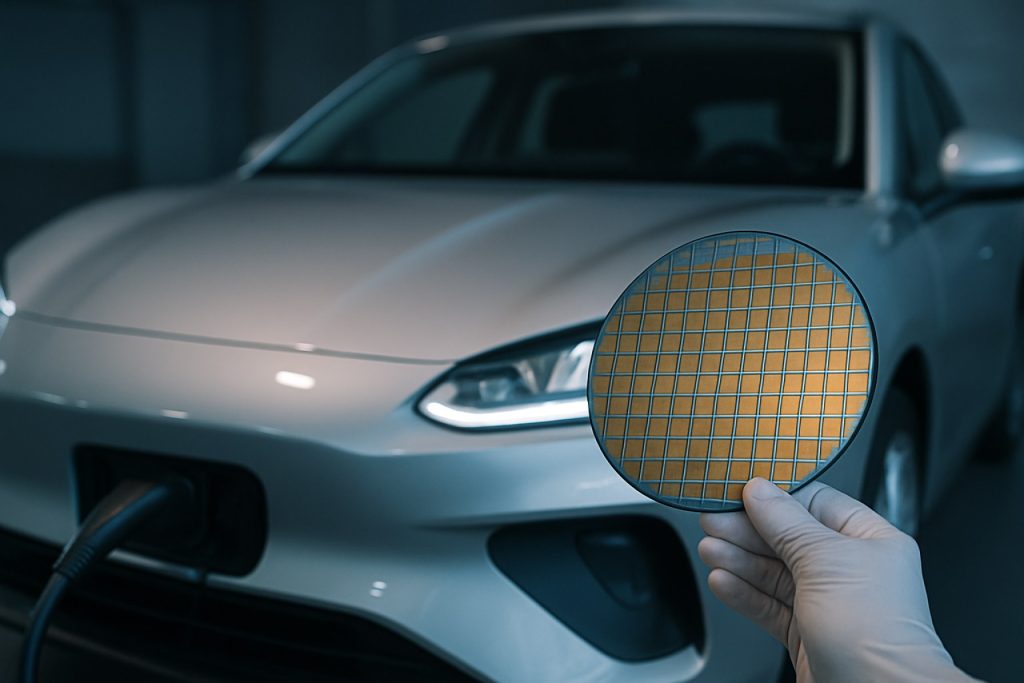
- Silicon anodes are revolutionizing lithium-ion batteries, offering up to ten times the energy storage capacity of traditional graphite anodes.
- Electric vehicles with silicon-based batteries will enjoy longer range, faster charging, reduced weight, and greater longevity—helping ease range anxiety.
- The global silicon anode battery market is set for massive growth, projected to reach $1.4 billion by 2032 with a 45% annual growth rate.
- Key challenges include silicon’s tendency to expand and degrade batteries, which are being addressed by nanotechnology and composite materials.
- Major automakers and startups are investing heavily in research and scaling up production to make silicon anode technology commercially viable.
- Beyond cars, silicon batteries will enhance consumer electronics and renewable energy storage, pushing the boundaries of efficiency and sustainability.
A flickering revolution pulses beneath the hood of every next-generation electric vehicle. Battery scientists, hunched over cleanroom benches from Silicon Valley to Shanghai, are chasing a dazzling goal: squeezing more life, speed, and power from the cells that run our world. The quiet hero in this race? Element number fourteen—silicon—now poised to catapult battery technology beyond the familiar limits of graphite.
In every lithium-ion battery, the anode is where the magic begins. Traditionally, graphite has filled this role, capably shuttling lithium ions but stifling the potential promised by electrified mobility. Silicon, long overlooked due to its volatile expansion during charge cycles, is rewriting the script. Thanks to breakthroughs in nanotechnology and composite engineering, this once-unruly element can now store more lithium—up to ten times the capacity of graphite by weight. The result? Batteries that pack more energy, charge at blistering speeds, and last longer, all while shedding critical pounds.
The significance ripples far beyond chemistry. Imagine electric cars that erase range anxiety, traversing hundreds of miles on a single charge. Picture pulling up to a charging station and reclaiming 80% of your battery in minutes rather than hours. With silicon as a key ingredient, these scenarios move closer to reality.
Vivid projections signal an oncoming wave. Financial analysts anticipate the global silicon anode battery market, currently valued at just over $100 million, will approach an eye-opening $1.4 billion by 2032—with annual growth rates near 45%. That’s not hype; it’s the reflection of skyrocketing demand from automakers, consumer electronics brands, and energy storage providers, all hungry for lighter, stronger, faster power sources.
Yet, the journey isn’t frictionless. Silicon is fickle; it swells dramatically as it absorbs lithium during charging, threatening to crack and degrade the battery’s structure. Researchers now deploy clever solutions—fusing silicon with carbon, forging resilient nanostructures, or embedding particles in flexible matrices—to tame this expansion. These sophisticated tricks mean batteries can survive thousands of cycles, even under the intense demands of long-haul travel.
Cost, too, has been a historic barrier. Mass-producing silicon anode material is still expensive. However, with titans such as Tesla, BMW, and Panasonic funneling resources into joint ventures and dedicated R&D, economies of scale loom on the horizon. Startups like Sila Nanotechnologies and Group14 Technologies, meanwhile, have quickened the industry’s pulse with laboratory breakthroughs now entering commercial pipelines.
Silicon’s rise reverberates beyond the open road. High-capacity batteries power everything— laptops, smartphones, wearables—stretching the time between charges and supercharging convenience. In the race to stabilize renewable grids, silicon-based batteries promise to capture solar and wind energy more efficiently, smoothing out the natural ebb and flow of clean power.
The message is clear: Silicon anodes aren’t just an incremental upgrade; they’re primed to lead an energy transformation. The nervous wait at the charging station and the mental math before every road trip may soon dissolve into memory. Electric vehicles will become bolder, lighter, and more liberating—not just for early adopters, but for everyone.
As the marketplace surges and new research paves the way, silicon stands ready to redefine mobility for a world hungry for speed and sustainability. The age of electric adventure—buoyed by the quiet, brilliant atom at the battery’s heart—has arrived. And in this unfolding chapter of technology, the road ahead stretches further, and faster, than ever imagined.
Silicon Batteries: The Game-Changer Transforming Electric Vehicles—What Every Driver Needs to Know
Introduction: Silicon Batteries Supercharge the EV Revolution
Silicon anode batteries are at the forefront of revolutionizing electric vehicles (EVs), promising unprecedented energy density, lightning-fast charging, and durable longevity. While the mainstream media highlights dramatic advancements, several crucial facts and practical insights remain underreported. For technology enthusiasts, investors, and everyday drivers, a nuanced understanding of silicon battery technologies is critical. Here, we unpack the science, market trends, and real-world impact, answering your biggest questions with expertise and actionable advice.
—
Key New Facts About Silicon Anode Batteries
1. Advancements Beyond Automotive: Real-World Use Cases
Silicon-anode batteries aren’t limited to electric cars. They are rapidly being integrated into:
– Consumer electronics (smartphones, tablets, laptops): Increasing device runtime and reducing charging frequency.
– Aerospace and drones: Lower battery weight directly translates to longer flight times and increased payloads.
– Wearable tech (smartwatches, fitness trackers): Extended battery life allows for more sophisticated features and health monitoring sensors.
– Stationary energy storage (solar, wind grids): High-capacity storage is vital for smoothing renewable energy supply fluctuations.
2. Silicon vs. Graphite: Detailed Comparison—Specs, Features, and Pros & Cons
| Feature | Silicon-Anode | Graphite |
|——————|———————|———————|
| Energy Density | Up to 10x higher | Standard baseline |
| Charging Speed | 2-5x faster | Modest |
| Lifespan | Improved (with nano-engineering) | Longer (traditional links) |
| Safety | Comparable, with improved designs | Very safe historically |
| Cost | High, trending lower | Low and stable |
| Sustainability | Abundant material, but energy-intense processing | Mature recycling path |
Pros (Silicon-Anode):
– Significantly increased driving range and reduced charging times.
– Enabler for lighter, smaller batteries (critical for aviation and mobile devices).
Cons (Silicon-Anode):
– Historically prone to swelling and degradation (being addressed via advanced nanostructures and composites).
– Currently more expensive than graphite solutions, but costs are decreasing.
3. Security & Sustainability: What Experts Are Saying
Silicon is the second-most abundant element in Earth’s crust, reducing worries over resource scarcity—unlike cobalt or nickel-dependent chemistries (source: USGS). The environmental impact of silicon mining is less severe than some alternatives, though processing remains energy-intensive. Leaders such as Tesla are spearheading efforts to increase recyclability and reduce the overall carbon footprint of battery manufacture.
4. Industry Trends & Market Forecast
– According to Research and Markets and other industry analysts, the global silicon anode battery market is slated for a compound annual growth rate (CAGR) exceeding 40% through 2032, driven by car manufacturers and renewable energy integration.
– Tesla’s 4680 battery form-factor, expected to incorporate higher silicon content, could help cut battery costs by up to 56% while improving range (source: Tesla Battery Day).
– European, American, and Asian manufacturers are racing to secure partnerships with emerging silicon anode tech startups such as Sila Nanotechnologies and Group14 Technologies, accelerating commercialization efforts.
5. Controversies, Limitations & Ongoing Debates
– Cycle Life: While silicon vastly improves energy density, its tendency to expand up to 300% during charging remains a challenge. Even with innovative nanoengineering, true “ultra-long life” for heavy-duty applications (long-haul trucking, grid storage) is still being optimized.
– Supply Chain Readiness: Scaling tech from laboratories to gigafactories is a non-trivial hurdle. Reliable, high-volume production of defect-free silicon nanocomposites is largely unproven at giga-scale.
– Competition: Solid-state batteries, lithium-sulfur, and sodium-ion chemistries are also vying for dominance, each with unique trade-offs for safety, cost, and performance.
—
Most Pressing Reader Questions—Answered
Q1: When Will Silicon Batteries Be Available in My Next Electric Car?
2025–2026 is the most realistic window for mass-market EVs sporting significant silicon content in their anodes. Premium devices (high-end smartphones) may see partial integration as soon as late 2024. Over the next decade, silicon anodes are set to become mainstream, especially as manufacturers address reliability and mass-production issues.
Q2: Will My Electric Car Charge Even Faster?
Yes! Expect the next generation of silicon-anode EV batteries to support 10–80% charging in as little as 10–20 minutes, compared to the current industry average of 30–60 minutes. This comes from both the silicon anode’s inherent capabilities and continuing improvements in battery management systems (BMS).
Q3: Are Silicon Batteries Safe?
With proper engineering controls—particle coatings, elastic binders, and advanced BMS—silicon anode batteries have proven safe in both lab and real-world tests. Still, as with all new tech, ongoing vigilance through regulatory oversight is warranted.
Q4: How Much More Will They Cost?
Initially, silicon batteries could add 10–20% to cell costs compared to graphite equivalents. However, as economies of scale ramp up and supply chains mature, costs are projected to fall below current graphite-based cells by 2028–2030.
—
How-To: Maximize the Benefit of Silicon-Anode Batteries
1. Stay Updated: Monitor announcements from leading automakers and tech brands (Tesla, BMW, Samsung) for the first commercial rollouts.
2. Smart Charging: Use manufacturer-recommended charging protocols; silicon batteries will accept high-speed charging, but longevity is maximized by adhering to guidelines.
3. Consider Use Case: Early adopters in high-demand applications (long commutes, heavy device usage) stand to benefit the most from silicon anode advancements.
4. Recycle Responsibly: Participate in manufacturer take-back programs to ensure batteries are recycled, reducing environmental impact and supporting a sustainable supply chain.
—
Actionable Recommendations & Quick Tips
– For EV buyers: Ask your dealer about battery composition, and watch for models explicitly using “silicon anode” or “next-gen” battery tech for the best range and charging speeds.
– For smartphone/laptop purchasers: Premium devices released in late 2024–2025 may offer double the battery longevity—research before upgrading.
– For investors: Track market leaders and startups in the silicon battery space. Growth is projected to eclipse $1 billion by 2032, making this a potentially lucrative sector.
—
Conclusion: The Road Ahead for Silicon Battery Technology
Silicon anode batteries are pivoting from scientific promise to practical revolution. Their impact will extend from daily commutes to grid-scale power and even airborne mobility. While challenges remain, especially around cost and cycle life, partnerships between automotive titans, startups, and research institutions are dissolving barriers faster than ever. Embrace the arrival of the silicon-powered era—it’s brighter, bolder, and closer than you think.
For additional updates and in-depth news on cutting-edge automotive technologies, visit Tesla.



